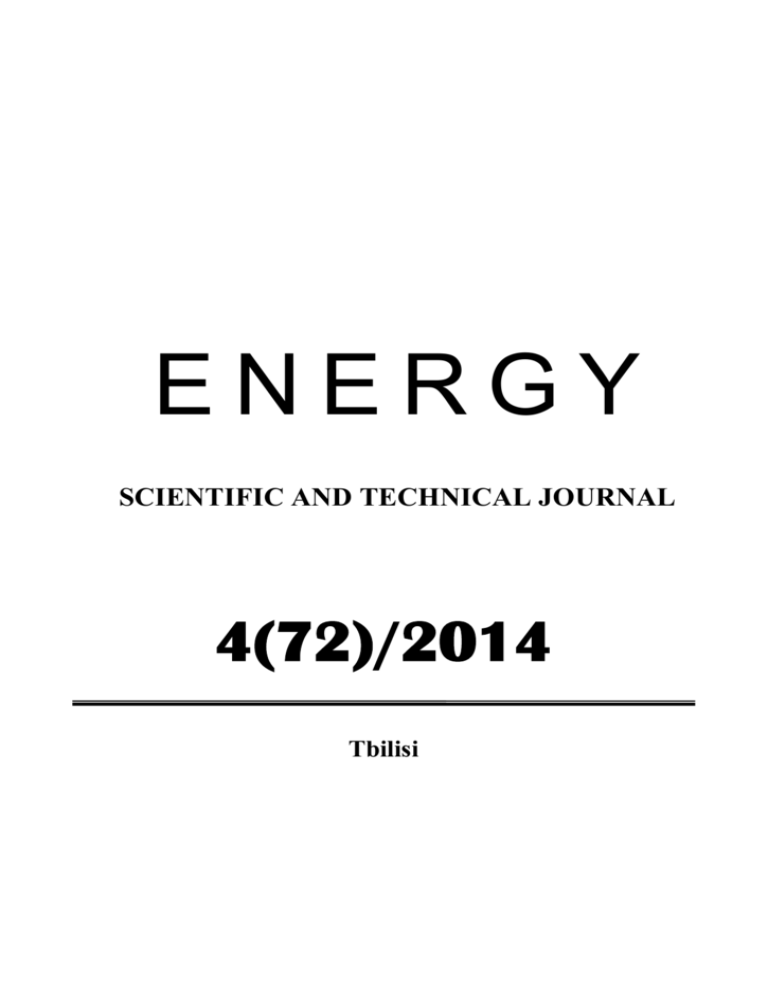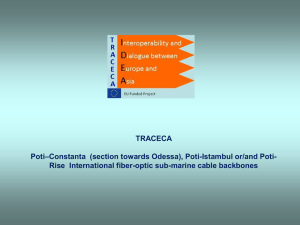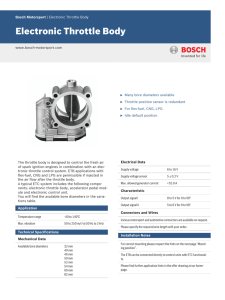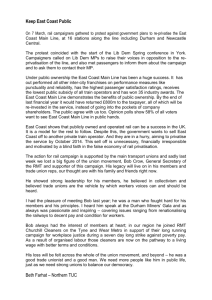Scientific Article 3
advertisement

ENERGY SCIENTIFIC AND TECHNICAL JOURNAL 4(72)/2014 Tbilisi Doctor of Technical Sciences, Professor IVANE SAGHINADZE Doctor of Technical Sciences, Professor SHALVA GAGOSHIDZE Doctor of Technical Sciences, Professor IURI KADARIA Supported by Programme “BLACK SEA 2007-2013” (ICME) ON THE ENVIRONMENTAL HYDRO-EGINEERING PROBLEMS IN THE BLACK SEA REGION OF POTI AND THE WAYS OF THEIR SOLUTION By the decision of President of Georgia and the Government of Georgia, the ancient maritime gateway – the town city of Poti and the territory adjacent to it (Fig.1) will be declared a free trade zone in the nearest future. A successful implementation of this decision of international importance much depends on the solution of quite a number of hydro-engineering, geo-morphological and environmental problems which have been existing since the early 50s of the past century. These problems (which will be briefly discussed below) are the clear example of adverse consequences for the environment as a result of scientifically unjustified engineering designs. Large-scale geo-morphological changes in the coast area of Poti started to occur after 1939 when the course of the Rioni river was completely diverted northwards from the city. Though this diversion protected the city from frequent floods, it at the same time created an irreversible deficit of beach-forming alluvia and, as a result, the sea coast of Poti was irreparably washed out by sea waves and diminished by hundreds of meters. To save the situation, a great number of coastprotecting structures were erected here and the coast was fortified with concrete blocks, crushed stone and boulders, but all the same these measures failed to stop the intensive process of sea coast erosion which became even more intensive after putting into operation the Gumati and Vartshikhe power plant cascades (the annual amount of solid sediments brought by Rioni waters after the construction of these cascades dropped from 2.07 million m3 to 1.35 million m3). Moreover, the diversion of the Rioni river course to the north created problems for navigation because of siltation of the inlet channel of the Poti sea port caused by north-western storms and sea currents. Removal of sediments dredges is very costly and every year the port administration has to spend tens of thousands of dollars on this work. To restore the washed-out sea coast of Poti, in 1959, the dam with a regulator (sluice) was built across the Rioni river, on the 7th kilometre to the north-east of Poti. Its purpose was to divide the river flow so that a part ( 400 m3/s) of the river discharge would go back to the former river bed (the so-called city channel) in order to compensate for a sediment deficit (600 m 3 per year). However even the discharge of 200 m3/s produced the flooding of the town because of the city channel siltation and the deformation of the channel outlet by sea waves (which occurred during the low water period). To protect the city from floods, the channel was enclosed with dams; two water collectors and a pumping station were built. However, these measures failed to provide the required water discharge rate. That was why in the 80s of the past century, in order to reconstruct the washed-out sea shore of Poti the pulp feed-line was erected along the city channel to transport inert materials from the Rioni river basin to the sea coast. But this feed-line soon went out of order and for various reasons was not restored. With a lapse of time, the downstream wall and the apron of the Rioni water dividing dam got essentially destroyed and the dam itself faced destruction. In 2006, it was partly rehabilitated (speaking more exactly, temporary measures were taken to rehabilitate it) according to the project prepared by the Saktskalproekti (Georgian Water Project) company. However this project was not concerned with the operation regime of the regulator and therefore with problems of restoration of the sea coast of Poti. Thus the water dividing dam with a regulating sluice failed to meet its purpose to deliver sediments to the sea coast. 20 Jurnali "energia" #4(72), 2014 Fig. 1. The location of the city of Poti This brief historical information clearly shows how topical it is to carry out scientific investigations of hydro-engineering and environmental problems existing in the Poti region and to propose such engineering measures that would facilitate to a maximal extent the restoration of the Poti coastline and protect the port of Poti from the inflow of river sediments. The objects of scientific investigation should be the following parts of the Black sea region of Poti (Fig. 2): 1. The sea water area between the port gate and the Nabada island. 2. The coastline of between the city channel outlet and the southern pier of the Poti port. 3. The water dividing dam on the river Rioni. 4. The bed and oulet of the city channel. 5. The water area adjacent to the southern pier of the Poti port. Fig. 2. The Lay-Out Map of the Hydro-Engineering and Environmental Problems in the Poti Region Jurnali "energia" #4(72), 2014 21 For the above-listed objects in the Poti region it is necessary to take the following steps: to collect and study the relevant hydrological and meteorological observations data, topographic and bathymetric maps and other materials; to organize expeditions to carry out field observations of the investigated objects; to process and classify the obtained data on geomorphological changes. It is also necessary to study the current projects on the extensive development of the Poti sea port and to identify the factors which caused the destruction of the downstream wall of the Rioni flow dividing structure. Other tasks include: To carry out field observations of the objects to be investigated in the framework of the project, some expeditions should be organized. Field observations should include the following work: preparation of bathymetric maps; determination of the parameters of sea currents, water surface roughness and river flows; observations of the migration of alluvia along the coast; collection of beach and river bed soil samples for the purpose of defining their composition; collection of sea and river water samples for the purpose of defining the concentration and chemical composition; video filming and photography and so on. Sounding and topographic survey will be carried out using the single beam echosounders Navisound 515 and GPS Leica 1200 (these instruments are available at Georgian Technical University). The fixation of wave perimeters and currents will be done using the special expedition ship and gauges owned by the Poti port (the cofinancing organization), whereas sample tests will be done at the water quality laboratory of Georgian Technical University. The ongoing projects and the variants on extensive development of the Poti port (Figs. 3, 4) should be studied and evaluated in terms of navigational safety. Based on the hydraulic analysis, the factors which caused the destruction of the downstream wall of the Rioni water dividing structure (Fig. 5) should be identified and investigated. Theoretical studies should pursue the aim to solve all current hydro-engineering and coast protection problems in the Poti port region. These studies should are also of fundamental importance, in particular: Solutions should be obtained for the case of propagation of longitudinal waves superposed on flows in channels of trapezoidal cross-section. Based on these solutions, relations will be derived for prediction of deformation of channel sides and also for a choice of dimensions of channel reinforcement elements (rock filling and facing slabs). Similar methods in the presently available normative documents are applicable only to the case of the frontal action of waves on the shore. The problem of intrusion of salt water (halocline) into river estuaries should be solved, taking into account the bottom slope angle. This is especially necessary for prediction of water quality and bed processes in the river estuaries in western Georgia. The existing methods of calculation of a halocline are applicable only to the case of large valley rivers whose slope angle is neglected because of its smallness. Fig. 3. Harbor of Poti 22 Jurnali "energia" #4(72), 2014 Fig. 4. The Plan of Poti Port Fig. 5. The Downstream Wall of the Rioni Water Dividing Structure It is advisable to solve problems of prediction of deformation and effective restoration of washed out bank slopes by using approximation methods of higher mathematics. These methods lead to obtaining relations convenient for designing engineers. The expected outcomes of these studies will be as follows. The operation regimes of the sluices of the water dividing structure (Fig.6) should be elaborated, the observance of which will provide a loss-free delivery of sediments from the river Rioni to the washed-out sea coast of Poti and thereby will contribute to the restoration of the coast. Jurnali "energia" #4(72), 2014 23 Fig. 6. Headworks of City Canal For the purpose of sea coast growth, possibilities of the pulp feed-line rehabilitation and construction of a sediment-retaining barrier along the underwater canyon located near the southern pier of the Poti port should be considered. Engineering measures for preventing the Poti port from siltation should be worked out taking into account variants of the reconstruction and extensive development of the Poti port. Engineering decisions will be proposed for the cleaning of the city channel bed and the increase of its capacity. These studies will make it possible to describe with high accuracy wave motions, alluvia drift and sea coast deformation in the Poti region and to take appropriate measures on restoring the washed out sea coast of Poti and to prevent the siltation of the entrance channel of the port. 24 Jurnali "energia" #4(72), 2014









